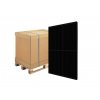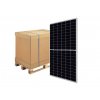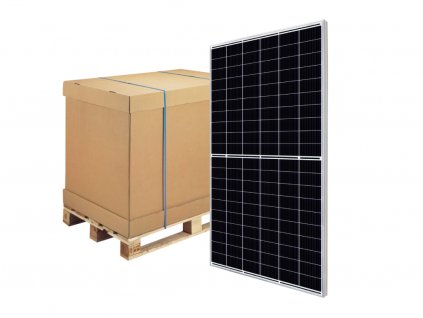Photovoltaic modules
We have photovoltaic panels at great prices. ✔️ we can advise you on the selection, ✔️ we are a proven e-shop.
Photovoltaic panels are an efficient renewable energy solution, allowing the use of solar energy to generate electricity. They work on the principle of capturing solar energy and then converting it into energy that can power household appliances and cars.
In our offer, you will find several types of photovoltaic panels, which differ according to the type of cells: monocrystalline, HJT (Heterojunction), TOPCon, and N-type monocrystalline. You can also choose according to the power output or according to reputable brands, Canadian Solar and Jinko Solar.
Choose photovoltaic modules according to the parameters
Bestsellers
How photovoltaic panels work
Photovoltaic panels are made up of several photovoltaic cells that are made of semiconductor materials, most commonly crystalline silicon. In this cell, in the presence of incident sunlight, a photovoltaic reaction takes place. In a nutshell, we can think of it as energetic photons from sunlight kicking electrons out of the atoms of the semiconductor material, forming loosely charged particles. Simply put, photovoltaic cells can absorb sunlight and generate an electric current due to the interaction of photons with the material's structure.
The three main types of photovoltaic panels
Our market's main types of photovoltaic panels include monocrystalline, polycrystalline and thin film (amorphous). Monocrystalline photovoltaic panels are among the most commonly used and most efficient, as their efficiency reaches up to 23%; the other two types have lower efficiency, with polycrystalline at 20% and amorphous at around 12%.
In our offer, you will find the following:
- Monocrystalline cells
Monocrystalline solar cells are easily identified by their black colour and cut edges. They are made from a very pure silicon, making them a very efficient material when it comes to converting light into energy. They are also the most space-efficient form of silicon solar cell - even in a small space, you can get a large amount of energy. They work better in low levels of sunlight, so if you want to use them in areas with lower levels of sunlight, they are the ideal choice. They also have a decent level of efficiency in all weather conditions. Monocrystalline cells are among the most extended lifespans, set at around half a century.
- N-Type Monocrystalline
For a better explanation of the N-Type panel, we will help with a comparison. Thus, there are several types of panels; we can recognize P-type panels and N-type panels. The main difference between the two photovoltaic panels is the number of electrons they contain. Both consist of silicon wafers, but in each case (P and N), they are mixed with other chemicals. In the case of the P-type panel, this is boron, and the N-type cell uses phosphorus. Boron has one less electron than silicon, making it a positively charged cell. For phosphorus, it is the opposite; it has one more electron than silicon, and the N-type cell is, therefore, negatively charged. N-type solar panels are an alternative that is becoming more and more popular. P-type panels have been the norm for years, but there is a reaction between boron and oxygen that sometimes reduces performance by up to 10%. Type N panels, doped with phosphorus, are immune to this reaction and performance is not reduced, so that we can talk about longer life and higher efficiency.
- TOPCon
TOPCon or Tunnel Oxide Passivated Contact. TOPCon technology belongs to type N cells. In producing a TOPCon cell, a layer of insulating material (a layer of "tunnel" oxide) is added to the back, located between the metal contact and the solar cell. This layer allows for better electron transport and collection, which also increases the efficiency of the cell. TOPCon panels, therefore, perform better even in poor lighting conditions. They are, therefore, the ideal choice for use in areas with lower sunlight or more shady locations.
Type N also includes PERT, TOPCon, HJT and IBC technologies.
- HJT (Heterocellular)
Heterojunction cells have been developed for even higher efficiency to get even more energy from the same amount of light. Thus, they combine two technologies in one cell: crystalline silicon and thin-film amorphous silicon. These layers form a thin film on the crystalline silicon cell. Combining these technologies makes it possible to obtain even more energy than would be the case using only one or the other.
Brand Canadian Solar Jinko Solar
Our e-shop offers photovoltaic panels from two renowned brands, Canadian Solar and Jinko Solar.
Canadian Solar is a global leader in solar energy solutions and storage. It is one of the top 5 manufacturers of solar solutions. Jinko Solar is a globally recognized company specializing in cutting-edge solar technologies.
Photovoltaic panel performance
The power of a solar panel is measured in watts. Most photovoltaic panels today have an output of between 380 and 660 watts per hour. The amount of energy a panel can produce depends on its production and various other factors and conditions.
What influences the efficiency of solar panels
In real-world, non-laboratory conditions, panels' efficiency depends on several external factors. Local conditions are capable of reducing panel efficiency and overall system performance. The main factors that affect the efficiency and performance of PV panels include:
- Solar radiation (W/m2)
- Shading
- Panel orientation
- Temperature
- Position (Latitude)
- Season
- Dust and dirt
- The direction the panel is facing
- Roof angle
How much power do you need
There is no clear answer to this question, as it depends on your average electricity consumption and the extent to which you want your house to be powered by the panels.
For those with low electricity consumption and who want to use the panels mainly to supplement their consumption, panels with a lower wattage (min. 380 W) should be sufficient. For households with high consumption or those who want to rely solely on solar energy, it is better to choose panels with a power output of around 445 W. The correct power output is an essential parameter when selecting a photovoltaic panel.
You can determine it based on your home's annual electricity consumption.
Are the panels suitable for every region of Slovakia?
Due to the characteristics of the cells described above, you do not have to worry about installing the panels even in the more northern areas of Slovakia. They are suitable for practically the whole territory, whether you live in Kysuce, Orava or the southern regions. In Slovakia, there are no significant differences in the amount of incident sun or solar energy, so geographical location does not play an essential role in the efficiency and performance of photovoltaic panels.
Return on investment or economic benefits of solar energy
In addition to the sustainability and cleanliness of the energy we get from the sun thanks to photovoltaic systems, one of the main reasons people are reaching for this type of energy is the economic benefits. The initial investment in solar panels can be higher, so it's important to choose efficient, tailor-made solutions and monitor the return on your investment. You can read more about the economics of solar energy on our blog.




























